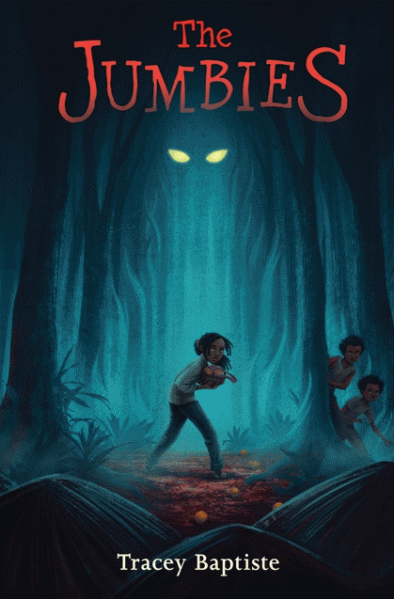Good morning! We’re three months away from Halloween, but hopefully you’re in the mood to be scared…because today’s guest is Tracey Baptiste, the author of THE JUMBIES and its forthcoming sequel. She’s with us today to talk about writing scary stories.


How to Write a Scary-But Not Too Scary-Story
Plotting a story for kids with a high fear-factor can be tricky. But to get an emotional reaction from the reader, whether that emotion is fear or joy works the same as it would for any other type of novel. It means tying all of the action pieces to an emotional reaction. In this case, that emotional reaction will be fear. But for little guys, it’s important that a scary story is not too scary. Frightening elements need to be cut with other things: humor, frustration, longing, success. And of these, humor is probably going to be your biggest ally.
To illustrate how this works, I’ll use the plot points from my own novel, The Jumbies, to chart the emotional reaction from the reader and show how to strike an emotional balance that doesn’t leave your reader cowering (unless of course, that’s your end goal). All emotional factors will be numbered 0-10, with 1 being only a moderate feeling, to a strong feeling at 10. Please note, these numbers are SUPER SCIENTIFIC.
|
Action |
Emotional Reaction |
|
The Jumbies begins with Corinne running through a dark forest after an animal. |
Not too scary. Fear factor 2.
|
|
Corinne worries that the animal she is chasing might attack. |
This could get bad. Fear factor 4.
|
|
She’s lost in the dark forest. |
We all have that fear of being lost. Plus dark forest? Fear factor 6.
|
|
She remembers a trick to get out and starts to exit. |
The reader will feel Corinne’s relief, but she’s not out yet. Fear factor 2.
|
|
But then something seems to be following her, and it snarls. |
Scary thing in the darkness. Snarl probably means something toothy! Fear factor 6.
|
|
She gets out of the forest and is immediately grabbed by a pair of hands. |
Has something gotten her? The toothy thing that snarled? Fear factor 7.
|
|
The hands turn out to be her father, they have a bonding moment. |
That’s a nice surprise! Fear factor 0/Love 5/Humor 3
|
|
But as they move away, the thing in the forest follows them out. |
Uh oh. It’s coming after her again, but she’s with her dad. Fear factor 3.
|

The action in chapter one is set up to prime readers for the scary bits throughout the story, but it doesn’t do so at top speed. It eases the reader in, gets stronger, and ends on just a slightly scarier note than where it started.
In chapter two, there is nothing scary at all. I needed to set up Corinne’s relationship with her father, and frankly, the readers need a break. But chapter three, which is purposefully short, is a steady hum of scariness that describes the main jumbie and introduces her motives. Chapter four again, has almost nothing scary in it until the very last line, but the next chapter amps up the scare factor again.

The plot points that create the emotions of love/friendship/humor follow each other, but go in the opposite direction of the plot points that create feelings of fear. This is the balancing act. Chapter by chapter, the plot allows for a very varied emotional response. It is a very purposeful emotional roller coaster that keeps kids turning the page, not knowing what will happen next.
Exercise:
Take out one chapter of the story you are working on and write out the action and emotional reaction you expect from the reader using the chart below. Then use a line graph (Click on the Insert tab, then Chart in Word) to plot out the emotional action.
|
Action |
Emotional Reaction |
|
|
|
|
|
|
|
|
|
|
|
|
|
|
|
|
|
|
|
|
|
Rules of thumb:
In opening chapters, you want to see more variation in the fear factor. The chart should be all over the place.
In middle chapters, the fear factor should be amped up, but so should other emotions.
Short chapters without much variation are OK, but should be preceded and followed by chapters that are quite different, emotionally.
In the final chapters, the fear factor should be at their highest levels, with other emotions only added in to increase the reader’s feelings of fear/worry for the main character.
Like all horror novels, it should not end on an emotional fear factor of zero. There should be something left over, that keeps the readers on their toes.
Feel free to share a bit of what you wrote today – or a reflection on this prompt (or just say hi to Tracey!) in the comments if you’d like!





Tracey, thanks for sharing. What a wonderful idea for keeping track of these emotions. Have you found it helps with the pacing too? I will give this a try with my work. Thanks again and best wishes.
Hi, Tracey.
I loved The Jumbies! It scared the pants off of me.
What a great lesson for today. I’m not writing a scary story, but I imagine I could use this method for charting the action parts of my ms. There’s certainly fear involved when a mc is in danger of losing everything they’re fighting hard to achieve.
Thank you for stopping by.
@Wendy it wasn’t the plan to scare the pants off people. I didn’t even realize it was horrid until it was finished. I just thought it was an exciting fairy tale! I think you can definitely use this to chart any emotion that features heavily in your work.
*horror* not horrid
@Martha I haven’t tried charting for pacing, but I bet it would work.
This is fascinating to see the behind the scenes look at scenes! Can’t wait to share this with students. I love the calculus of this. I want to pull apart my WIP to see its emotional progression. Thanks for coming to camp today!
Tracey, I love this idea of tracking emotions. I see it as a wonderful way to check in on my pacing. Your post is timely and I will work on it after my bike ride. Thank you!
Tracey,
Thanks for sharing such a unique lesson today. I am not writing anything scary right now, but I am working to improve building emotional intensity. Thanks again!
Hello all!
I’m glad this tracker worked for you. I think I did most of it intuitively. I didn’t really look at how it all panned out until much later in the writing process, but once I knew how I was revving up, and then slowing down the scare factor, I was much more conscious of it as I revised. I’m definitely more aware of that balance now as I’m working on the sequel.
Tracey – Thank you so much for joining us today and for your very informative lesson. I love the examples that you posted and I plan to adapt for my 5th grade writing. Sometimes it is difficult to get students to see that their writing is flat and that it needs a bit of revision. I think using peer pairs to assist one another plot out the emotions of their stories will be a great interactive learning experience that helps students become better writers. Thanks for the writing idea spark.
Tracey, thanks for your post today. I don’t have a work in progress yet but if I ever get to that point I hope I will remember to do this.
BTW – Your book The Jumbies was next up on my to read pile. I’m supposed to write the questions for it for our school district’s version of Battle of the Books. After seeing your graph I’m looking forward to reading it.